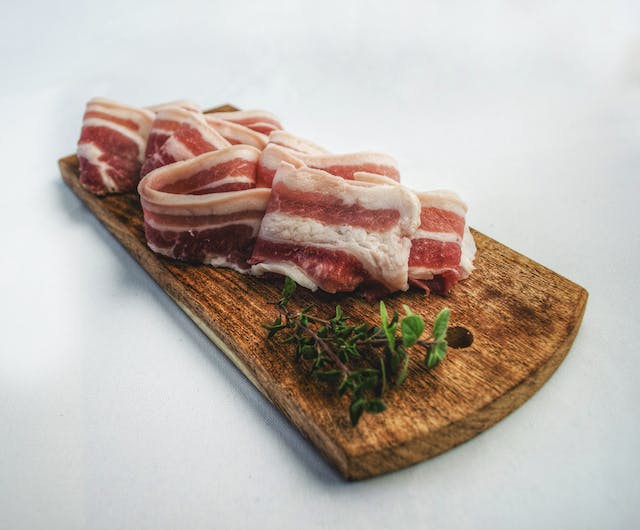This post will guide you through how to tell if pork is bad. A good rule of thumb is that if you smell anything weird like a strong sour smell, throw it out immediately to avoid food poisoning.
Pork is a favorite for many because it just tastes so good. Why is it so popular? Well, the simple truth is that it’s fantastic, no matter how you treat, cure, or cook it. Whether it’s ham, pork ribs, pork chops, sausages, or bacon, pork shines in various delicious forms. However, all those thoughts of yumminess take a back seat when pork goes bad. So, how can you tell if pork has gone bad?
Generally, when pork starts to go bad, it gives off a sour smell that gets stronger over time. Raw pork also changes color and becomes slimy to the touch. If cooked pork is left in a warm place overnight, it might not show any signs of being bad, but it could make you sick if you eat it. Do not eat any pork that you are not sure whether or not is fresh. Throw it out immediately.
Many cuts of pork are as lean as, and sometimes even leaner than, chicken. They pack more vitamins and minerals than poultry. For instance, skinless chicken breast and pork tenderloin are both lean meats. If you eat pork regularly, your senses—like taste, smell, and eyesight—will tell you if the pork has gone bad.
| Sign | Description |
|---|---|
| 1. Color Change | Raw pork turns from pink to grey or even greenish. |
| 2. Slimy Texture | Raw pork feels slimy or sticky. |
| 3. Strange Smell | Raw pork develops a sour or ammonia-like odor. |
| 4. Sour Odor | Cooked pork gives off a sour smell, indicating spoilage. |
| 5. Unrefrigerated | Leftover cooked pork left out overnight can make you sick. |
Related>>>How to Tell if Cabbage is Bad
How to tell if pork is bad – 5 Tips
1. Color Change
One way on how to tell if pork is bad is a noticeable transformation in the color of raw pork is a key indicator of spoilage. The familiar pinkish hue shifts to grey and, in more severe cases, even takes on a greenish tint. This color change signals the presence of bacteria that compromise the freshness and safety of the meat, making it essential to discard pork displaying such alterations.
2. Slimy Texture
Spoiled raw pork develops a slimy or sticky texture on its surface, reflecting a breakdown in the meat’s structure. This change in texture is a clear sign of bacterial activity, indicating that the pork has surpassed its prime and may pose health risks if consumed. The slimy feel is a direct consequence of spoilage and serves as a tangible cue to avoid using the pork in any culinary preparations.
3. Strange Smell
This is the easiest give a way sign on how to tell if pork is bad. The typical meaty smell of raw pork transitions to a sour or ammonia-like odor when it goes bad. This change in smell is a reliable indicator of spoilage microorganisms at work. The presence of these odors signifies bacterial and parasitic activity, emphasizing the importance of trusting your sense of smell to assess the freshness and safety of the pork before consumption.
4. Sour Odor in Cooked Pork
Cooked pork that emits a sour odor has likely undergone spoilage, challenging the common belief that cooking eliminates all spoilage organisms. This occurrence suggests the survival or introduction of harmful bacteria post-cooking, which can lead to foodborne illness. The detection of a sour smell in cooked pork is a strong warning sign to refrain from consuming the dish.
5. Unrefrigerated Leftovers
Cooked pork left unrefrigerated, particularly in warm conditions, can pose health risks upon consumption. Even if there are no immediate noticeable changes, pathogenic organisms responsible for causing diseases may multiply in unrefrigerated cooked pork. Harmful bacteria, such as Salmonella, could be present, emphasizing the need to exercise caution and proper storage practices to prevent potential illness.
More on How to tell if pork is bad
What makes pork go bad? Bacteria make pork go bad, especially when it’s in the temperature danger zone (40 to 140 degrees Fahrenheit). Keeping pork cold helps prevent bacteria growth.
Can you cook pork even when it has gone bad? Technically, yes, but it’s not safe. Spoiled pork already has a bunch of bacteria, and cooking it won’t make it safe to eat. Trust your sense of smell—if it’s bad, throw it out.
How does bad pork apply to frozen pork? Freezing slows bacterial growth but doesn’t stop it entirely. If pork wasn’t spoiled before freezing, you can eat it, but be cautious of any unusual smells, color changes, or slimy texture after defrosting.
In conclusion, there are many delicious cuts of pork to enjoy, but it’s crucial to know how to tell if pork is bad to avoid eating contaminated food.

